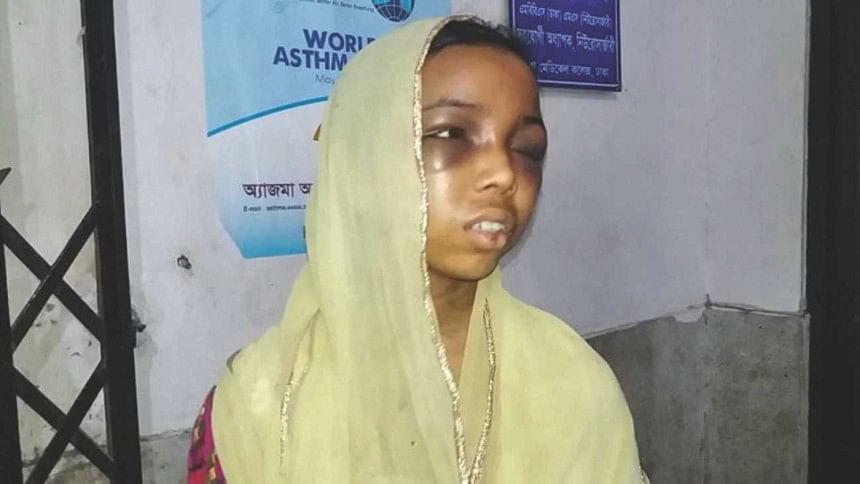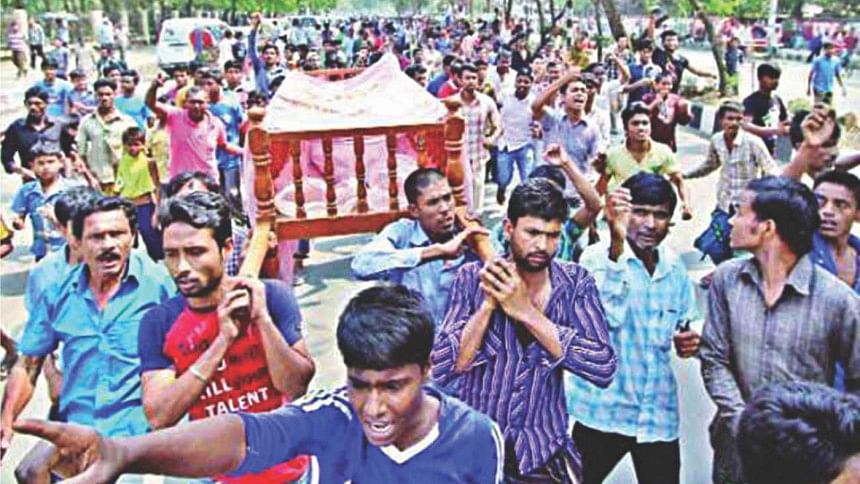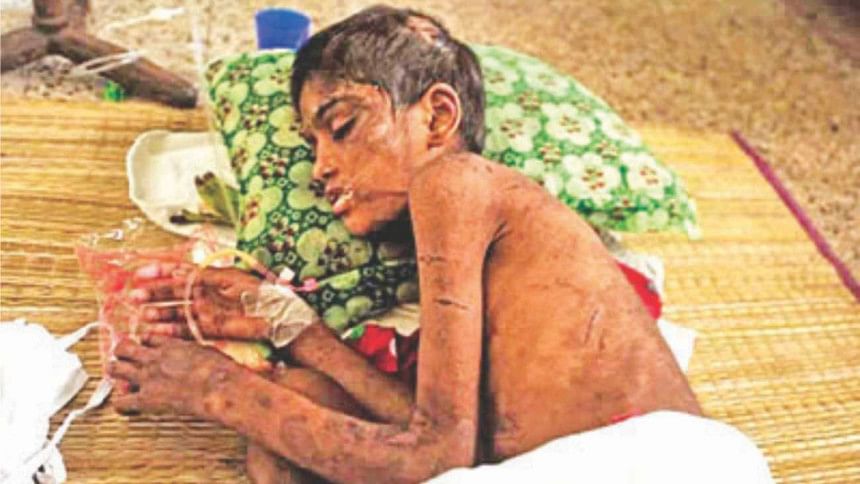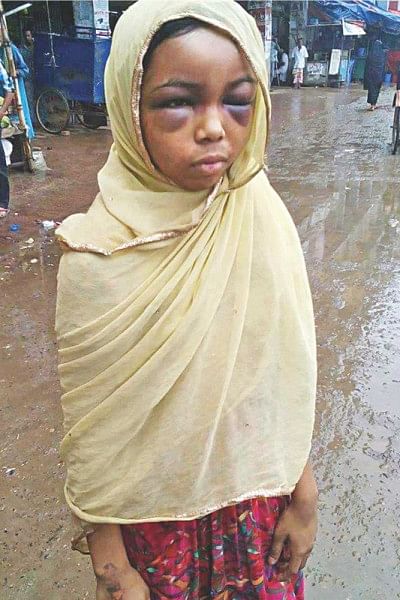The never ending cycle

Earlier this month, 11-year-old domestic helper Sabina Akhter was allegedly beaten by her landlord, Ayesha Latif (35), wife of Lt Col Taslim Ahsan, in Mirpur DOHS. The picture of the child—her eyes swollen and black, her hands severely scarred—went viral on social media, drawing the attention of people of all social classes. In fact, there were thousands of Facebook posts condemning the cruelty of abusing a child like that, just for breaking the yolk when making a poached egg.
The officer-in-charge, Dadan Fakir of Pallabi Police Station, informs that Sabina managed to escape from the house, and later, with the help of a journalist, came to the station to file a case against her landlord. "Sabina notes in her statement that her eyes became swollen and black as she was hit repeatedly with a bread roller. Besides, her forehead, head, back and hips were severely wounded," says Fakir. The statement also mentions that Sabina's landlord burnt her chest and hands with the hot cooking ladle.
On social media, we lose no time in expressing our "shock" over such inhumane behaviour; the activist in us may even post a moving Facebook status demanding exemplary punishment of the accused. But in reality, how many of such cases actually see the light of justice?
On March 6, 2016, 12-year-old domestic helper Jania Begum was reportedly raped, killed, and thrown off from the rooftop of the residential quarters of Non-Aligned Movement officials in Mirpur. On the 23rd of the same month, 15-year-old domestic worker Jannat Akter Shilpi was found hanging from the ceiling of the home of well-known singer Krishnakali. On September 6 the year before, 11-year-old domestic worker Mahfuza Akter Happy was allegedly beaten and tortured by her employers, cricketer Shahadat Hossain and his wife Jesmin Jahan Nrittya.
There are too many Sabinas, Janias, Shilpis and Happys in our societies who are treated, even in this day and age, as slaves by their employers. Unfortunately, we do not have any specific data on how many domestic workers are employed in Bangladesh currently. A glance through the recent data of Ain O Salish Kendra (ASK) shows that from January 2012 to June 2017, a total of 388 incidents of violence against domestic workers have taken place, and, of them, only 161 cases have been filed over the years.
On Tuesday, the court, after almost four years, convicted Nawrin Jahan with a fine of BDT one lakh for abusing her domestic worker Aduri and sentenced her for life imprisonment. The 11-year-old was rescued by a police inspector from a dustbin, half-dead, in the capital's DOHS Baridhara.
However, in an overwhelming majority of cases, the perpetrators get away scot-free, especially when it involves employers who are in relative positions of power within our society.
The accused in Sabina's case, Ayesha Latif, is still absconding. "The police have already conducted raids in all possible places where she could be hiding," says Sub Inspector (SI) Asif Iqbal of Pallabi Police Station, who is also the Investigating Officer (IO) of the case.

Curiously, although Sabina was admitted first to the One-stop Crisis Centre (OCC) of Dhaka Medical College Hospital (DMCH), she was later transferred to the Combined Military Hospital (CMH) Dhaka. Since the OCC is equipped to address all the needs of a female victim in one place—such as healthcare, police assistance, DNA test, social services, legal assistance, psychological counselling, and shelter—it raises the question, why was she sent to CMH?
"OCC victims can be sent anywhere for better treatment if his or her IO has consented or ordered it," informs Brigadier General Md. Mizanur Rahman, Director of DMCH. "In the issue of Sabina, the army authority expressed their interest to undertake full responsibility for her, which is why she was sent there for better treatment with the permission of the IO. We did not hand her over to the army or CMH authority, rather, we have handed her over to the IO," he explains.
The IO, on the other hand, says that he gave his consent because DMCH referred her to CMH for better treatment. However, since DMCH already serves patients with severe ailments and the OCC, since its inception, has a record of serving 29,778 victims up to June 2017, the reason behind sending Sabina to CMH remains unclear. It raises another question—was there any pressure? Curious still is the fact that since she was moved to CMH, the OC, IO and even Bangladesh National Women Lawyers Association (BNWLA)—which has been providing legal assistance to this case—have failed to establish any communication with her parents.
However, when contacted by Star Weekend, Sabina's father Md Badal informs that they have already "mutually solved" the case, as they don't want to pursue the legal process. "We have already signed the agreement and the employers of Sabina have ensured that they will take full responsibility of her health. We have requested them to find a job for my daughter in the future. They have also agreed to help us when Sabina gets married at the request of my wife," says Badal.
When asked about the violence against his daughter, Sabina's father says, "Maybe the 'madam' slapped her once or twice because Sabina misbehaved. My daughter is so young; she might have been compelled by the journalist, who took her to the police station, to file a case."

It is not uncommon for parents or families of victims, especially young girls, who hail from impoverished backgrounds, to withdraw their cases when financial assistance is offered. For example, after Jania's murder, a murder case was filed by her father Osman Gani. Agitated locals and her relatives even staged a demonstration with her body in front of the Kafrul Police Station, demanding the arrest of her murderers immediately. According to media reports, Jania's corpse was found on the ground floor of the building with a piece of cloth tied around her mouth; there were numerous scratches and bruises on private parts of her body. However, within a year, the case was dismissed, by none other than the father himself.
"The case finally ended with Jania's father's sending a written application to the High Court stating that he wanted to dismiss the case, since his daughter had died from falling off the building, and the accused government official Ahasan Habib, his wife Naznin Akhter and son Rummon Bin Ahsan, were not involved. The doctor's report does not show anything related to rape or physical torture either," says SI Kamruzzaman of Kafrul Thana, who was the IO of the case.
The same thing happened in the incident involving Happy, where Shahadat and Nrittya were acquitted as the prosecution failed to prove them guilty—as if the whole incident was a ghostly event, or a fabrication of the media. A search on Google still shows pictures of a wounded Happy, but there are no explanations as to what really happened to her. Happy herself gave a statement basically to the effect that she was not tortured by the couple. Nrittya rebuked her sometimes, as she did not want to work or could not perform her tasks properly, but that was all.

Syed Sultan Uddin Ahmed, Assistant Executive Director of Bangladesh Institute of Labour Studies (BILS) and co-ordinator of Domestic Workers Rights Network (DWRN), says, "In cases involving violence against domestic workers, the complainants come from poor families and are helpless, while the opponents are always powerful. After a certain period, the cases lose momentum in the face of constant pressure by the accused on the victim's family, or most of the time, through mutual agreement."
It is also difficult to prove the allegations since the torture happens inside the house, he adds.
Advocate Salma Ali, Executive Director of Bangladesh National Woman Lawyers' Association (BNWLA), also highlights that in cases of domestic workers' abuse, the most important thing is the victim's witness protection. "Since we cannot provide proper protection for the victims or their witnesses, at one point in time, they are compelled to 'mutually solve the case' in return for money," says Ali. Given that the victims come from impoverished backgrounds, it makes sense for them or their families to accept the money in the face of constant pressure and a prolonged and uncertain legal battle.
"Besides, since the victims usually have very little understanding on what to do, they do not even get proper access to justice and find the process very lengthy. In most cases, they are forced to settle everything with the help of the police or locally influential people," explains Ali.
With the legal system biased towards the affluent, it falls on the state to ensure justice for domestic workers, believes Sultan. "In addition, the burden of proof must fall on the accused, rather than the victim, in the case of domestic abuse," he says.
The cases of violence against domestic workers are dealt with under the Women and Children Repression Prevention Act 2000 and Penal Code 1860.
Unfortunately, even though they are an integral part of our economy, domestic workers are not even counted in our Labour Force Survey. Although the draft Domestic Workers Protection and Welfare Policy finally got approved in December 2015 following continuous pressure from human rights organisations, there has hardly been any progress in terms of implementation. Sultan argues that nothing can be achieved unless there is proper monitoring.
Apart from the reported cases, a study of 565 child domestic workers from Dhanmondi, Mohammadpur and Mirpur areas conducted by Bangladesh Shishu Adhikar Forum (BSAF) found that 97 of them were physically abused, 137 mentally, 36 sexually, and 156 verbally by their employers.
Any kind of abuse—be it physical, mental, sexual or verbal—is an offence in the eyes of the law. However, the harsh reality is that if reported cases are not dealt with properly, or if we cannot set an example by bringing the perpetrators to book, the current scenario of violence against domestic workers will not change.

 For all latest news, follow The Daily Star's Google News channel.
For all latest news, follow The Daily Star's Google News channel. 



Comments